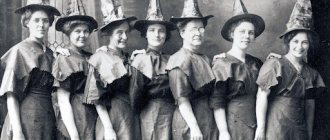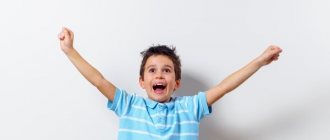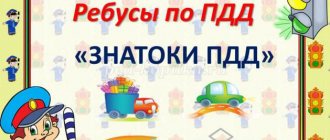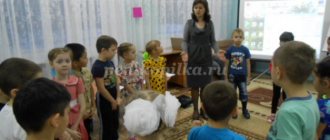Children at the age of 5 should already show an interest in mathematics, be able to count, understand what numbers are, know the numbers of the natural series, understand tens, solve arithmetic problems, and practice composing difficult problems. During these years, it would be better to start introducing children to letters, it would be good to teach children to read, and focus on sounds. Preschoolers must imagine what days of the week, months, and seasons there are. It is necessary to use special sets and visual materials for teaching preschool children. There is no need to let your preschooler get bored.
Mathematics in pictures No. 1
Mathematics in pictures No. 2
Mathematics in pictures No. 3
Mathematics in pictures No. 4
This article describes part of a lesson with five-year-old children (CLUB OF THE FUN AND REVENTIVES). Between thematic tasks, there are pictures in which you can also get ideas for math classes with children 5 years old.
Math task in pictures No. 5
Mathematical KVN, tasks for children 5 years old
Age: five years.
What materials and equipment are needed for this math lesson?
First of all...a fan with numbers. Secondly...Puzzle "Mongolian game". Thirdly...Box numbers. Fourthly...Characters of the fairy tale “Turnip”. Fifthly... Medals, tasty prizes, awards.
Educator: tells the children that they will have KVN that day, says that MISTRESS MATHEMATICS has again invited the children to visit. What is KVN?
The children say that this is a CLUB OF FUN AND REVENTIVES, a game.
The teacher begins to work with the children. Creates two teams - “Circles” and “Ovals”, which will fight with each other. The jury consists of parents and educators present at the lesson. Each team will need to complete tasks, each competition will be worth 1 point.
Math task in pictures No. 6
Recommendations for conducting mathematical classes
Let's start with the fact that mathematics classes for children 5-6 years old should be held in a playful way. This method of learning material is optimal for preschoolers. If you just sit your child down in front of his textbooks, he may quickly get bored and switch his attention to something more interesting (the landscape outside the window, fancy patterns on the wall, etc.). As a result, such “burdensome” and “tiring” lessons will only cause him irritation. And every invitation from parents to study mathematics will be met with hostility. Here are other tips for organizing lessons:
- Exercise only when the child is in a good mood. Attempts to force a preschooler to study without his desire can lead to absent-mindedness and poor concentration. Since children 5-6 years old have predominantly involuntary memory, it is much easier for them to remember information that evokes positive emotions.
- Study regularly, periodically adding something new to your lessons. It's no secret that young children become bored with monotony very quickly. And if they lose interest, the information is unlikely to stick in the heads of young students. In addition, lessons should be conducted systematically so that preschoolers can constantly update their knowledge and develop acquired skills and abilities.
- If a child fails at something or cannot understand the essence of the task, do not be nervous and irritated . You need to methodically explain the task to the preschooler until he has no questions left. Excessive parental demands and negative assessments of a child’s actions can once and for all discourage him from studying mathematics.
- And finally, you cannot “stand” over children, forcing them to solve one problem after another. Although this method of teaching will lead to the assimilation of the material, it will discourage the preschooler from learning. Therefore, all classes should be held in an easy and interesting way. Developmental mathematics for children 5-6 years old requires the child’s involvement in the process, his direct participation in the development and solution of problems, personal initiative, and the use of fantasy and imagination. The combination of all these components is the key to effective learning.
L.G. Peterson, developer of the elementary mathematics course “Igrachka”: “Often, the preparation of preschoolers comes down to teaching them reading, writing and counting. According to research, serious difficulties in primary school are faced not by those children who have a meager amount of skills and knowledge, but by those who demonstrate passivity and do not want to think and learn something new. In this regard, the main goal of primary training should be the diversified development of the child: his creative and intellectual abilities, personality traits, motivational factors. In this case, special attention must be paid to connecting fantasy and imagination. It is creativity, along with the ability to create and invent something new, that contributes to the formation of a preschooler’s personality, the development of his independence and cognitive interest.”
First task: “Solve examples”
The teacher gives each child a fan with numbers... Then he reads problems that the children will need to listen to carefully and solve. It is noted that a fan is required for answers. The winner is the group that solved the problem correctly and quickly.
1. Five fox cubs are digging in the sand, Two fox cubs are bathing in the ash. Tell me how many there are.
The kids show the answer.
2. Five turkeys bought boots. Help me count them.
The kids are counting.
After this, the teacher conducts a warm-up (describe circles with straight arms).
Math task in pictures No. 7
Entertaining mathematics
Parents of preschoolers should use their imagination when developing activities. It is not at all necessary to conduct lessons sitting at the table when there are so many exciting things and phenomena around. So why not use them for arithmetic purposes? For example, you can involve children in preparing their favorite dishes, be it pizza or apple pie. Ask your child to count out two cups of flour and allow them to pour it into a prepared bowl themselves. Give your preschooler the task of fetching five eggs from the refrigerator, carefully placing them in a bowl. Let the child independently add three tablespoons of sugar, etc., to the dough. Such entertaining mathematics will not only bring great pleasure to the child, but will also be etched in his memory for a long time.
You can count anything, anywhere. To do this, it is not at all necessary to find time and set up your child for classes.
Most likely, he himself will not understand that he is involved in the learning process. For example, when getting ready for kindergarten in the morning, ask your preschooler to count the number of buttons on his shirt. And when you arrive at the hospital, determine the number of patients sitting in the queue. And how many objects to count can you find while walking down the street! Cars near the house, people at the bus stop, birds flying in the sky, floors of buildings - and this list is almost inexhaustible.
Alexandra, mother of eight-year-old Andrey: “My son and I learned to add and subtract at the age of 5. And they did it immediately in their minds, without using sticks or bending their fingers. Let's go somewhere, count the objects, and then add 1 to them. For example, three cars are parked near the store and then another one drives up to it. The son adds up in his mind and gives the answer. Later they began to add 2, 3, and so on in increasing order. Then they changed the order of calculations. They began to add a larger number to a smaller number. This, of course, was more difficult, but over time we got used to it. We walk a lot. At a minimum, a daily “walk” to the garden and back. Now we are already visiting the school, the journey to which takes 20 minutes in one direction. So there's plenty of time. We’re done with counting, now we’ve started learning English words using the same method.”
Third task: “Solve an arithmetic problem”
The teacher needs to read the problem... The children then need to write down the solutions using signs, numbers in the box of numbers. The winner is the team whose participants gave the correct answers and quickly completed the task.
Tamara has three flowers. Kostya gave her two more. Help me count the flowers.
Children write down solutions.
Math task in pictures No. 8
Video on the topic
SOURCE
Mathematics Message Series:
Part 1 - Make Your Own Game Series. Find a house for each number. Part 2 - Geometric shapes. Lessons 3 in 1. ... Part 26 - How to easily learn the Multiplication Table. Part 27 - Fun counting for preschoolers. Problems within the top ten in pictures. Part 28 - Mathematics for children 5-6 years old Part 29 - Teaching your child to count - easy, fun, effective and interesting: a guide for moms and dads.
Advice from psychologists and teachers
Reluctance to study mathematics can arise for various reasons. The child may not understand it because of his young age. Sometimes a five-year-old child does not have the ability to calculate. Often preschoolers with a humanitarian mindset ignore numbers , but read fluently and write well.
Parents should not overreact to their child’s reluctance to count. If he has an ability for mathematics, but does not want to study, it is necessary to convey to him the importance of the educational process. It is recommended to discuss this issue frequently, demonstrating in practice the need for mathematical calculations.
When a preschooler does not perceive numbers, you need to surround him with them. To do this, use drawings and cards with numbers. Sheets of paper are hung around the house, periodically drawing attention to them. With this approach, your child will quickly begin to add and subtract numbers.
Another practical piece of advice from teachers is to include numbers in speech when communicating with a preschooler. You can play different games in which you need to count down time or recite poems with time. Over time, the child himself will become interested in exact science. If he does not accept game and classical methods of teaching counting, use sweets. When a preschooler gives the correct answer to a given problem, he receives candy. This technique will spur his desire to quickly master the skill of counting.
Mathematics for children 6 years old is considered a fascinating and interesting science. The main thing is to make the right choice in the form of training. Activities should not burden children. Ideas for conducting entertaining lessons are all around us, just use your imagination. If you solve arithmetic problems in a playful way, then the preschooler will receive additional motivation to find the correct answer. He will strive to receive the reward by becoming the winner. Scientists have proven that it is during the game that new information is perfectly remembered.
The advantages of learning with the help of mathematical games are the clarity of the material being studied and the development of abstract thinking. Brightly designed number games based on clear examples will help children learn to independently analyze, compare objects and memorize arithmetic operations. At the same time, exciting mathematics for children 5-6 years old will help them get involved not only in the world of numbers and logic, but will also become a starting point for modeling - one of the components of the development of a preschooler’s creative abilities.
Copybooks and games
Number flashcards help little ones become familiar with basic math concepts.
With such material, memory and thinking develop. To get used to the pen, you can buy copybooks or write figures and numbers in a notebook yourself. Such classes are carried out from the age of 5. They develop perseverance. Copybooks help develop accurate writing skills. Entertaining mathematics for children 5 and 6 years old includes logic problems and educational games. You can come up with fun logical tasks yourself , for example, which is heavier: 1 kg of fluff or 1 kg of iron. Didactic or educational games are carried out in any setting (while walking, sitting in line at the pediatrician, etc.).
If the child loves drawing more than mathematics, it is better for parents to conduct classes in a playful way:
- Claps. The game develops mathematical abilities and auditory perception. The adult claps his hands with different frequencies and strength, and the child counts the number of beats.
- Focus. Small objects are clenched in a fist and hidden behind the back. A preschooler, knowing how many objects are in one hand, must count how many are hidden in the other fist. If he answered correctly, the adult guesses. If the answer is incorrect, the items are hidden in a different quantity.
- Extra. 20 pictures of different categories are cut out from magazines: plants, transport, food, furniture. Images of the same theme are laid out on the table. Several pictures from another category are added to them. The preschooler must find extraneous drawings by counting their number. The remaining images from the same category are also counted.
- Number. This group game is played with a ball. Children stand in a circle with an adult in the center. The ball is thrown one by one, and the number is called. Each kid must return the ball to the leader, saying the next number in order.
- Drawing. Arithmetic for 5 year olds should be fun. For this purpose, teachers have developed didactic materials with dot drawing lessons. Children, connecting elements, draw lines in order from one number to another.
- Walker. The path is marked on the playing field. You need to use it to get from one point to another. Children take turns throwing the dice, counting the number of dots they get, and make their moves. The count is limited from 1 to 12. If 6 and 3 are rolled, the child must calculate the sum of these numbers. The next move is made after the player adds the numbers correctly.
- Shop. Child sellers offer adult buyers to purchase products at different prices. You can make a real calculation if you go to the store with your child. Gradually, the baby will be able to determine the amount of change himself. Frequent trips to the store will help him learn to count faster.




